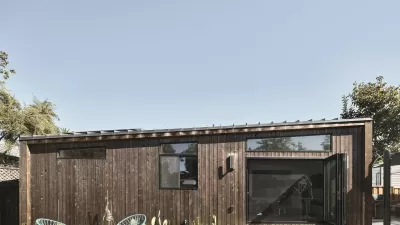A California cooperative brings together investors to make homeownership more accessible and finance housing projects that help to slow gentrification.

Oscar Perry Abello looks at the East Bay Permanent Real Estate Cooperative, an organization in the San Francisco Bay Area that facilitates purchase and shared ownership of properties for low- and moderate-income households. With funding from investors, the cooperative is pursuing affordable housing projects while also promoting a vision and goals that differ from those of conventional real estate development ventures.
"The cooperative sees its work as an attempt to demystify the entire process of real estate — securing properties for acquisition, assembling capital stacks, and managing properties for the long-term — so that community organizers everywhere, of every marginalized group, can bring in communities to participate as an active player in their own development instead of just being passive recipients or victims of displacement," says Abello.
One feature that distinguishes the cooperative, he says, is the fact that investors do not have to be residents of the properties. "In some ways EB PREC resembles the savings-and-loan associations of yesteryear, where neighbors invested into a communal pot of money that they took turns borrowing from in order to support each other’s acquisition of property," notes Abello.
FULL STORY: A New Kind of Cooperative in Oakland Fights Against Speculative Development

Trump Administration Could Effectively End Housing Voucher Program
Federal officials are eyeing major cuts to the Section 8 program that helps millions of low-income households pay rent.

Planetizen Federal Action Tracker
A weekly monitor of how Trump’s orders and actions are impacting planners and planning in America.

Ken Jennings Launches Transit Web Series
The Jeopardy champ wants you to ride public transit.

California Invests Additional $5M in Electric School Buses
The state wants to electrify all of its school bus fleets by 2035.

Austin Launches $2M Homelessness Prevention Fund
A new grant program from the city’s Homeless Strategy Office will fund rental assistance and supportive services.

Alabama School Forestry Initiative Brings Trees to Schoolyards
Trees can improve physical and mental health for students and commnity members.
Urban Design for Planners 1: Software Tools
This six-course series explores essential urban design concepts using open source software and equips planners with the tools they need to participate fully in the urban design process.
Planning for Universal Design
Learn the tools for implementing Universal Design in planning regulations.
Ada County Highway District
Clanton & Associates, Inc.
Jessamine County Fiscal Court
Institute for Housing and Urban Development Studies (IHS)
City of Grandview
Harvard GSD Executive Education
Toledo-Lucas County Plan Commissions
Salt Lake City
NYU Wagner Graduate School of Public Service




























